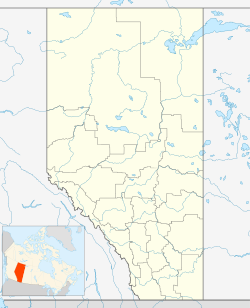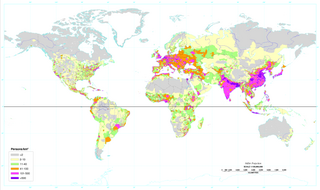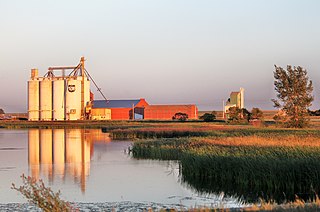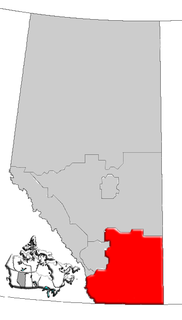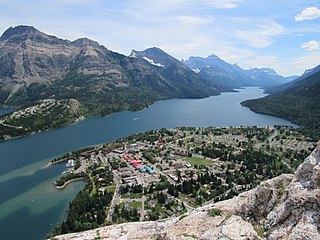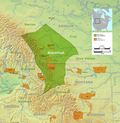Blood 148 | |
|---|---|
| Coordinates: 49°30′N113°12′W / 49.5°N 113.2°W Coordinates: 49°30′N113°12′W / 49.5°N 113.2°W | |
| Country | |
| Province | |
| Government | |
| • Chief | Roy Fox |
| • Governing body | Kainai Nation |
| Area | |
| • Total | 1,413.87 km2 (545.90 sq mi) |
| Population (2016) [1] | |
| • Total | 12,027 |
| Time zone | UTC-7 (MST) |
| Highways | Highway 2 |
| Website | http://www.bloodtribe.org |
Blood 148 is a First Nations reserve in Alberta, Canada. It is inhabited by the Blood (Kainai) First Nation and was established under the provisions of Treaty 7. [2] This reserve is managed from the town of Stand Off on its northwest border and encompasses the majority of lands bounded by the cities of Fort MacLeod, Lethbridge and Cardston. It is traversed by Alberta Highway 2, Highway 5 and Highway 509. The St Mary River and the Belly River are major rivers supplying and draining the lands.
In Canada, the First Nations are the predominant indigenous peoples in Canada south of the Arctic Circle. Those in the Arctic area are distinct and known as Inuit. The Métis, another distinct ethnicity, developed after European contact and relations primarily between First Nations people and Europeans. There are 634 recognized First Nations governments or bands spread across Canada, roughly half of which are in the provinces of Ontario and British Columbia.
In Canada, an Indian reserve is specified by the Indian Act as a "tract of land, the legal title to which is vested in Her Majesty, that has been set apart by Her Majesty for the use and benefit of a band."

Alberta is a western province of Canada. With an estimated population of 4,067,175 as of 2016 census, it is Canada's fourth most populous province and the most populous of Canada's three prairie provinces. Its area is about 660,000 square kilometres (250,000 sq mi). Alberta and its neighbour Saskatchewan were districts of the Northwest Territories until they were established as provinces on September 1, 1905. The premier is Jason Kenney as of April 30, 2019.
Contents
At 1,413.87 km2 (545.90 sq mi), this is the largest reserve in Canada, and the third most populous after Six Nations and Akwesasne. On June 12, 2019 Federal Courts awarded an additional 162.5 sq mi of unspecified lands to bring its total area to 708.4 sq mi. It is located between the Cities of Fort MacLeod and Lethbridge and the Town of Cardston, bordering the Municipal District of Willow Creek No. 26 to the northwest, the Lethbridge County to the northeast and Cardston County to the east, south and southwest.

Six Nations is the largest First Nations reserve in Canada. As of the end of 2017, it has a total of 27,276 members, 12,848 of whom live on the reserve. It is the only reserve in North America that has representatives of all six Iroquois nations living together. These nations are the Mohawk, Cayuga, Onondaga, Oneida, Seneca and Tuscarora. Some Lenape also live in the territory.
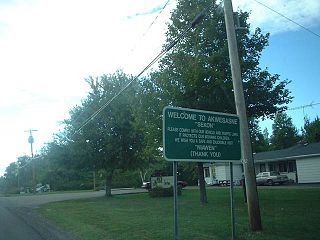
The Mohawk Nation at Akwesasne is a Mohawk Nation (Kanien'kehá:ka) territory that straddles the intersection of international borders and provincial boundaries on both banks of the St. Lawrence River. Most of the land and population are in what is otherwise the present-day United States. Although divided by an international border, the residents consider themselves to be one community. They maintain separate police forces due to jurisdictional issues and national laws.

Lethbridge is a city in the province of Alberta, Canada, and the largest city in southern Alberta. It is Alberta's fourth-largest city by population after Calgary, Edmonton and Red Deer, and the third-largest by land area after Calgary and Edmonton. The nearby Canadian Rockies contribute to the city's warm summers, mild winters, and windy climate. Lethbridge lies southeast of Calgary on the Oldman River.
